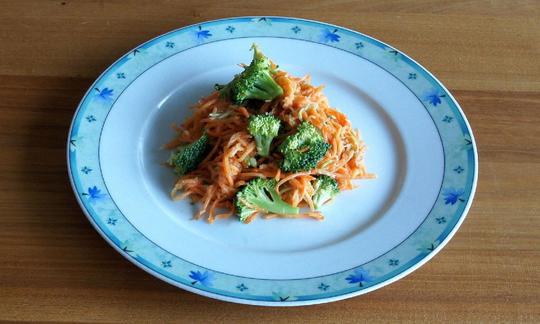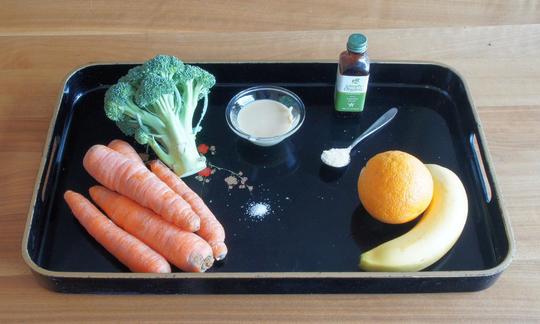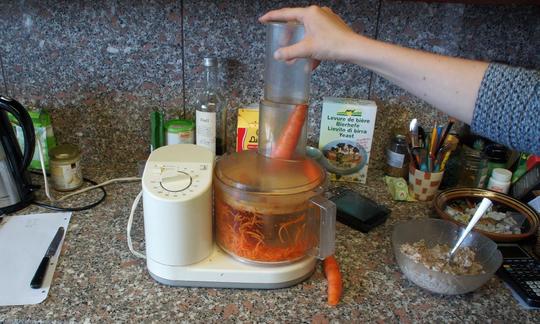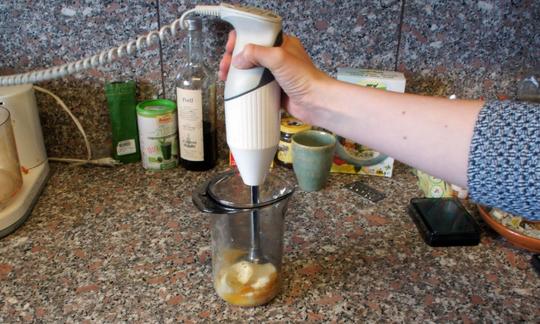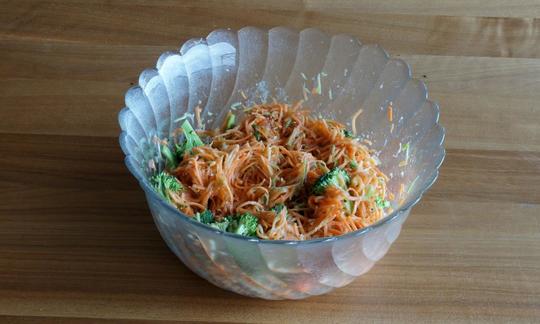Carrot-Broccoli with Vanilla Sauce with Banana and Orange
raw-vegan
Ingredients (for servings, )
| For the vegetable base | |
|---|---|
| 5 | Carrots (carrots), raw (organic?) (11 oz) |
| 1 | Broccoli, raw (brocoli, broccoli, broccoli, asparagus cabbage) (5.3 oz) |
| For the vanilla sauce | |
| 1 | Bananas, raw (organic?) (4.1 oz) |
| 1 | Oranges, raw (organic?) (4.6 oz) |
| 1 ½ tbsp | White almond butter, raw? (organic?) (0.63 oz) |
| 2 dash | Table salt (table salt, raw?, organic?) (0.03 oz) |
| ⅓ oz | Yeast flakes: noble yeast, nutritional yeast, yeast powder (raw?, organic?) |
| 1 tsp | Vanilla extract, natural (organic?) (0.15 oz) |
Equipment
- hand-held blender / immersion blender or blender
- food processor or grater
Type of preparation
- chop or grind
- purée
- grate (shred)
Preparation
For the vegetable base
Wash the carrots, cut off the ends and grate them using a food processor.If you do not have a food processor, you can also process the carrots using a kitchen grater.
Cut the broccoli into bite-sized pieces and grate the hard broccoli stalks into the carrots using a food processor.
As with the first preparation step, you can use the kitchen grater (rasp, rasp) as an alternative.
For the vanilla sauce
Peel the banana and cut into small pieces, peel the orange and fillet it.To fillet the oranges, first remove the top and bottom ends with a straight cut. Then place the orange on the cutting surface and separate the peel from the flesh with semicircular cuts. Now remove any remaining white skin and cut the individual fillets along the white membranes.
Puree the banana and orange pieces using a hand blender. Add the almond butter, table salt, yeast and vanilla extract and mix well.
Place the vegetable base of carrots and broccoli in a bowl and add the vanilla sauce. Mix everything well and serve.
|
Nutritional Information per person
Convert per 100g
|
2000 kcal | |
|---|---|---|
| Energy | 127 kcal | 6.4% |
| Fat/Lipids | 3.3 g | 4.7% |
| Saturated Fats | 0.32 g | 1.6% |
| Carbohydrates (inc.dietary fiber) | 22 g | 8.2% |
| Sugars | 11 g | 12.6% |
| Fiber | 5.7 g | 22.7% |
| Protein/Albumin | 4.5 g | 9.0% |
| Cooking Salt (Na:144.4 mg) | 367 mg | 15.3% |
| Essential micronutrients with the highest proportions | per person | 2000 kcal | |
|---|---|---|---|
| Vit | Vitamin B1 (Thiamine) | 1.1 mg | 104.0% |
| Vit | Vitamin A, as RAE | 653 µg | 82.0% |
| Vit | Vitamin C (ascorbic acid) | 58 mg | 73.0% |
| Vit | Vitamin K | 49 µg | 65.0% |
| Vit | Vitamin B9, B11 (Folate, as the active form of folic acid) | 64 µg | 32.0% |
| Elem | Potassium, K | 560 mg | 28.0% |
| Vit | Vitamin B6 (pyridoxine) | 0.36 mg | 26.0% |
| Prot | Threonine (Thr, T, irreversibly transaminated) | 0.22 g | 23.0% |
| Sodium, Na | 145 mg | 18.0% | |
| Min | Manganese, Mn | 0.36 mg | 18.0% |
Detailed Nutritional Information per Person for this Recipe
The majority of the nutritional information comes from the USDA (US Department of Agriculture). This means that the information for natural products is often incomplete or only given within broader categories, whereas in most cases products made from these have more complete information displayed.
If we take flaxseed, for example, the important essential amino acid ALA (omega-3) is only included in an overarching category whereas for flaxseed oil ALA is listed specifically. In time, we will be able to change this, but it will require a lot of work. An “i” appears behind ingredients that have been adjusted and an explanation appears when you hover over this symbol.
For Erb Muesli, the original calculations resulted in 48 % of the daily requirement of ALA — but with the correction, we see that the muesli actually covers >100 % of the necessary recommendation for the omega-3 fatty acid ALA. Our goal is to eventually be able to compare the nutritional value of our recipes with those that are used in conventional western lifestyles.
| Essential fatty acids | per person | 2000 kcal |
|---|---|---|
| Linoleic acid; LA; 18:2 omega-6 | 0.71 g | 7.0% |
| Alpha-Linolenic acid; ALA; 18:3 omega-3 | 0.02 g | 1.0% |
| Essential amino acids | per person | 2000 kcal |
|---|---|---|
| Threonine (Thr, T, irreversibly transaminated) | 0.22 g | 23.0% |
| Tryptophan (Trp, W) | 0.03 g | 14.0% |
| Isoleucine (Ile, I) | 0.14 g | 11.0% |
| Valin (Val, V) | 0.17 g | 11.0% |
| Lysine (Lys, K, irreversibly transaminated) | 0.18 g | 10.0% |
| Phenylalanine (Phe, F) | 0.16 g | 10.0% |
| Leucine (Leu, L) | 0.21 g | 9.0% |
| Methionine (Met, M) | 0.05 g | 5.0% |
| Vitamins | per person | 2000 kcal |
|---|---|---|
| Vitamin B1 (Thiamine) | 1.1 mg | 104.0% |
| Vitamin A, as RAE | 653 µg | 82.0% |
| Vitamin C (ascorbic acid) | 58 mg | 73.0% |
| Vitamin K | 49 µg | 65.0% |
| Vitamin B9, B11 (Folate, as the active form of folic acid) | 64 µg | 32.0% |
| Vitamin B6 (pyridoxine) | 0.36 mg | 26.0% |
| Vitamin B2 (Riboflavin) | 0.23 mg | 17.0% |
| Vitamin E, as a-TEs | 1.7 mg | 14.0% |
| Vitamin B3 (Niacin) | 2.1 mg | 13.0% |
| Vitamin B5 (Pantothenic acid) | 0.80 mg | 13.0% |
| Vitamin B7 (Biotin, ex vitamin H) | 6.3 µg | 13.0% |
| Essential macroelements (macronutrients) | per person | 2000 kcal |
|---|---|---|
| Potassium, K | 560 mg | 28.0% |
| Sodium, Na | 145 mg | 18.0% |
| Magnesium, Mg | 45 mg | 12.0% |
| Calcium, Ca | 77 mg | 10.0% |
| Phosphorus, P | 63 mg | 9.0% |
| Essential trace elements (micronutrients) | per person | 2000 kcal |
|---|---|---|
| Manganese, Mn | 0.36 mg | 18.0% |
| Copper, Cu | 0.13 mg | 13.0% |
| Zinc, Zn | 0.55 mg | 6.0% |
| Iod, I (Jod, J) | 8.9 µg | 6.0% |
| Iron, Fe | 0.76 mg | 5.0% |
| Selenium, Se | 1.5 µg | 3.0% |
| Fluorine, F | 7.6 µg | < 0.1% |
The recipe for carrot and broccoli with vanilla sauce, banana and orange has a sweet note with a delicate almond aroma thanks to its combination of ingredients.
Carrots and carotenes: The carrot is a popular low-calorie raw food and is known primarily for its high carotene content. Carotenes are fat-soluble, secondary plant substances. The best-known representative is so-called beta-carotene, which gives the carotene group its name and is also an important precursor in the body's own production of retinol (vitamin A). For this reason, it is also called pro-vitamin A.
In plants, carotenoids serve in photosynthesis and protection against UV radiation, while their formation in plant roots protects against infections.
While the cancer-protective effects of beta-carotene in humans are the starting point of many debates, there is agreement regarding their cell-protective effect as antioxidants. Furthermore, synthetically produced beta-carotene is finding its way into our everyday lives as a food coloring (e.g. margarine) or food additive in vitamin preparations. Since carotenes are fat-soluble, the human organism needs a small amount of fat to utilize them.
Yeast / almond butter and raw food: Strictly speaking, yeast flakes are no longer raw food, as the yeast is inactivated using heat during the usual manufacturing processes. As a strict raw foodist, you can switch to other ingredients if in doubt.
Almond butter is usually steam-treated, but there are also suppliers of raw almond butter. Some of these products can also be found in health food stores.
Alternative kitchen appliances: If you don't have a food processor at home, you can grate the carrots and broccoli stalks with a grater. This way it will take a little longer.
Suitable side dish: If you are a little more hungry, this dish can be served with half an avocado and mustard or honey.
Apple: Instead of an orange, you can also use an apple.

